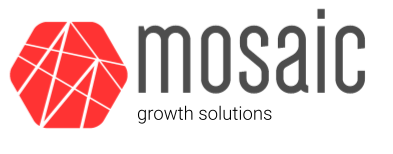We’ve discussed the importance of accurate performance reporting in previous Mosaic Minutes. Not only is it a way to consistently track progress against goals but it is also a good way to spot potential problems. In looking at a client’s reporting on a weekly basis, it became apparent that while leads increased from the previous month by over 100%, the incremental volume was not moving through the funnel to create a corresponding increase in opportunities. In other words, this client had a funnel problem, a potential leak it seemed.
To understand what was happening, we pulled together a meeting with the go-to-market team. We were a little apprehensive going into the meeting because we weren’t entirely sure of team dynamics. Would the marketing team point a finger without listening to the sales team? Would the sales team be defensive from the start? Would the meeting be productive at all?
To ensure alignment and focus, we established a clear, achievable meeting objective – to gain a shared understanding of how leads were flowing through the funnel. We made sure the discussion stayed anchored in the data and reporting that both teams had signed off on previously. And, as it turned out, the meeting was very successful. The marketing team listened to the sales team’s feedback on lead quality. The sales team was receptive to suggestions from the marketing team on how best to engage with the leads. Both teams recognized the need to better map the process and define funnel stages. We determined clear action items and owners. Both teams walked out of the room with the same understanding of what needed to happen and a commitment to getting it done quickly. The next month the client set records for opportunities and pipeline created.
What made this cross-functional meeting so effective? Four things:
- Clear Objective & Agenda: Articulating an achievable goal to ensure that everyone in the room is aligned on what you are trying to accomplish and a clear agenda to follow is essential to a productive meeting. For this meeting, we used a simple map of the funnel to guide our discussion.
- Accurate Data: We let the data drive our discussion. Since we had previously gotten buy-in and sign-off from all business leaders (if you haven’t done this yet, read this), we didn’t have to waste time discussing whether the data was accurate. Instead, we dove right into aligning on what the data is telling us.
- Shared Prioritization: Both teams viewed a productive meeting (one that resulted in a clearly laid out plan of action) as critical to future success. This strong prioritization and alignment at the top trickled down to the teams and definitely helped to minimize finger-pointing and blame-shifting.
- Right People: We ensured all the right stakeholders came together. The last thing you want to do is talk about what one team is doing (or not doing) when they are not actually in the room. We were also fortunate to have the leaders in the room. This meant decisions could be made in real-time, increasing productivity and progress.
TL;DR
Addressing sales and marketing alignment can be difficult (and often a dreaded task), but the right context and approach can make it far less painful. Remember, stronger alignment across the go-to-market team is essential for effective funnel management. In other words, ensuring your sales and marketing teams have a good working relationship has a significant impact on the growth of your organization, and most importantly, your bottom line.


Recent Comments